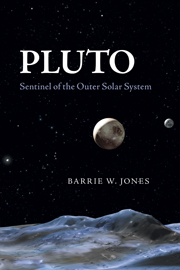Book contents
- Frontmatter
- Contents
- List of tables
- Preface
- Acknowledgements
- 1 The Solar System
- 2 The discovery of Uranus, Neptune and Pluto
- 3 Pluto: a diminishing world
- 4 Pluto's family
- 5 Surfaces, atmospheres and interiors of Pluto and Charon
- 6 The Edgeworth-Kuiper belt
- 7 Is Pluto a planet?
- 8 The New Horizons mission to Pluto (and beyond)
- 9 Pluto: gateway to beyond?
- Glossary
- Further reading and other resources
- Index
2 - The discovery of Uranus, Neptune and Pluto
Published online by Cambridge University Press: 05 December 2011
- Frontmatter
- Contents
- List of tables
- Preface
- Acknowledgements
- 1 The Solar System
- 2 The discovery of Uranus, Neptune and Pluto
- 3 Pluto: a diminishing world
- 4 Pluto's family
- 5 Surfaces, atmospheres and interiors of Pluto and Charon
- 6 The Edgeworth-Kuiper belt
- 7 Is Pluto a planet?
- 8 The New Horizons mission to Pluto (and beyond)
- 9 Pluto: gateway to beyond?
- Glossary
- Further reading and other resources
- Index
Summary
Before I tell you the story of Pluto's discovery, it is both instructive and relevant to the discovery of Pluto for you to learn, briefly, about the discovery of Uranus and, in more detail, about the discovery of Neptune. Between them, these three planets were found by strikingly different means.
THE DISCOVERY OF URANUS
Until 1781 just five planets were known: Mercury, Venus, the Earth, Mars, Jupiter and Saturn, all readily visible to the unaided eye. Then, on 26 April of that year a scientific paper was read to the Royal Society that opens as follows.
‘On Tuesday the 13th of March, between ten and eleven in the evening, while I was examining the small stars in the neighbourhood of H Geminorum, I perceived one that appeared visibly larger than the rest: being struck with its uncommon magnitude, I compared it to H Geminorum and the small star in the quartile between Auriga and Gemini, and finding it so much larger than either of them, suspected it to be a comet.’
This is the opening of a paper written by the Germano-British astronomer William Herschel (1738–1822). It was read to the Royal Society by the British physician William Watson (1744–1825). Thus was announced to the world the discovery, not of a comet, but of what was soon shown to be a planet. Its true nature was clear by May 1781 after its large, low eccentricity orbit had been established.
- Type
- Chapter
- Information
- PlutoSentinel of the Outer Solar System, pp. 37 - 73Publisher: Cambridge University PressPrint publication year: 2010



